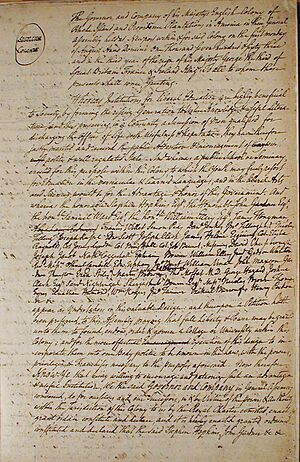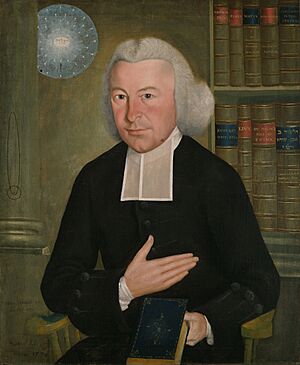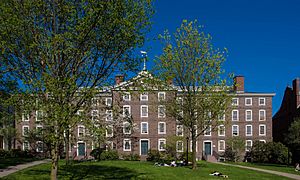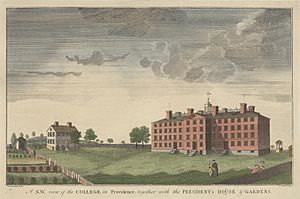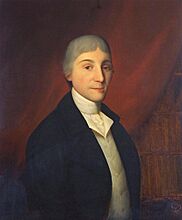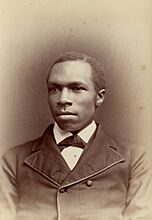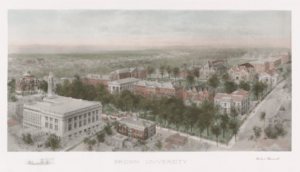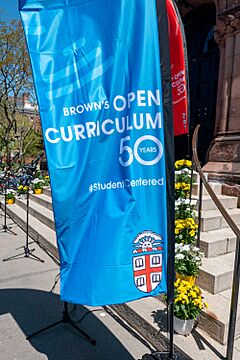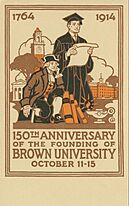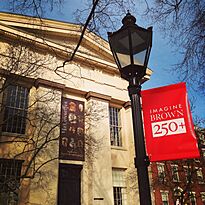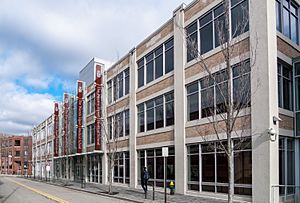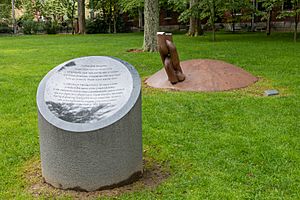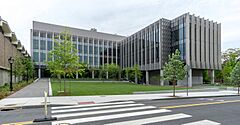History of Brown University facts for kids
The history of Brown University began in 1764. It was first called the College in the English Colony of Rhode Island and Providence Plantations. Brown is the seventh-oldest college in the United States. It is also the third-oldest college in New England. When it was founded, Brown was the first U.S. college to welcome students no matter their religious affiliation. Brown's medical program is the third-oldest in New England. Its engineering program is the oldest in the Ivy League.
In the late 1800s, Brown became one of the first U.S. colleges to offer advanced degrees. It added master's and doctoral studies in 1887. In 1969, Brown started its Open Curriculum. This new way of learning changed how students chose their classes. In 1971, Pembroke College, Brown's women's college, fully joined the university.
Contents
How Brown University Started
The First Idea for a College
Brown University's story began in 1761. Three people from Newport, Rhode Island, wrote a letter to the colony's government. They wanted to open a school for young men. This school would teach languages, math, geography, and history. They also wanted to build a place for students and teachers to live.
One of these people was Ezra Stiles. He was a pastor and later became president of Yale University. Another was William Ellery, Jr., who later signed the United States Declaration of Independence. The third was Josias Lyndon, who became the colony's governor. Stiles wanted a college where different religious groups could learn together. He believed in free thinking and shared knowledge.
Why Baptists Helped Start Brown
The Philadelphia Association of Baptist Churches really pushed for a college in Rhode Island. Rhode Island was home to the first Baptist church in America. At that time, Baptists did not have their own college. Other religious groups did. For example, Congregationalists had Harvard and Yale. Presbyterians had the College of New Jersey. Episcopalians had the College of William and Mary and King's College.
In 1762, the Philadelphia Association decided it was a good idea to build a college in Rhode Island. They wanted Baptists to lead it. They thought James Manning, a recent graduate of Princeton, would be a good leader.
Writing the College Charter
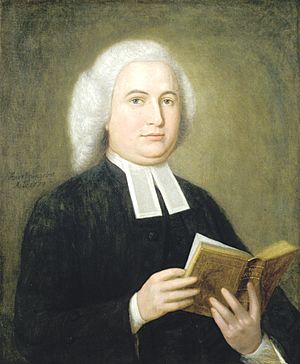
James Manning came to Newport in July 1763. He met Ezra Stiles, who agreed to write the college's charter. Stiles's first draft was shown to the government in August 1763. But Baptist members did not like it. They felt their group would not have enough power.
So, a new charter was written. This new charter made sure Baptists had control over the college's main groups. It was approved on March 2 and 3, 1764, in East Greenwich. Ezra Stiles was upset by this. He felt it made the college too focused on one religious group. He did not join the college's leadership.
More than sixty people signed the charter. This included the brothers John, Nicholas, and Moses Brown from the Brown family. The college was later named after Nicholas Brown, Jr. because of his generous gift. The charter said the college's goal was to prepare students to be useful and respected citizens. It would teach languages, arts, and sciences.
Brown's charter was very forward-thinking for its time. Other colleges had rules against different ideas. But Brown's charter said, "Religious differences of opinions, shall not make any Part of the Public and Classical Instruction." This meant all students could learn freely.
In September 1764, the college's first meeting was held in Newport. Governor Stephen Hopkins became the chancellor. The charter stated that the Board of Trustees should have 22 Baptists, five Quakers, five Episcopalians, and four Congregationalists. Eight of the 12 Fellows, including the president, had to be Baptists. The others could be from any group.
Where Brown First Started
The college was first called Rhode Island College. It was located in Warren, Rhode Island, at the First Baptist Church. James Manning became the college's first president in 1765. He stayed in this role until 1791. The first graduation was held in Warren in September 1769. The original church building was burned down in 1778 by British and Hessian soldiers. Today, the First Baptist Church of Warren stands on that same spot.
In 1769, people started talking about building a new college building. They wondered if Warren should be the college's permanent home. They wanted a place with clean air, good morals, and religious freedom. Providence was chosen because it was central and had a lower cost of living. The Brown family helped pay for the new building.
In 1770, the college moved to its current location in Providence. People in Newport were not happy about this move.
Building the Campus
After moving to Providence, work began on a permanent campus. This led to the building of University Hall. In 1770, John and Moses Brown bought land in Providence for the school. This land was part of the original property of their ancestor, Chad Brown. A committee planned the college's first building.
On February 17, the committee asked for donations of wood and other materials. Many people helped, including merchant Aaron Lopez. The workers who built the hall came from many backgrounds. They included enslaved people, free people of color, Native Americans, and white laborers. Construction started on March 26, 1770. The roof was finished in October of that same year.
How Brown Got Its Name
When Brown first opened, tuition was $12 a year. This was not enough to cover costs. So, the college looked for donations. In 1766, Reverend Morgan Edwards traveled to Europe. He raised $4,300 for the college. Among the donors were Thomas Penn and Benjamin Franklin. Another trip to the American South raised an extra $1,700.
The Brown family was very important in moving the college to Providence. They helped build its first building and secure its funding. Nicholas Brown Sr., his son Nicholas Brown, Jr., John Brown, Joseph Brown, and Moses Brown were all key figures. Joseph became a professor. John was the treasurer from 1775 to 1796. Nicholas Jr. took over as treasurer from 1796 to 1825.
On September 8, 1803, the college decided that a $5,000 donation would allow the donor to name the college. The next year, Nicholas Brown, Jr. made this donation. On September 6, 1804, he gave $5,000 to create a special teaching fund. In thanks, the college was renamed Brown University that same day. Nicholas Brown, Jr. gave nearly $160,000 over the years. This included money for Hope College (1821–22) and Manning Hall (1834-35).
In 1904, the John Carter Brown Library was created on Brown's campus. It was based on the private book collection of John Carter Brown, Nicholas Brown, Jr.'s son.
The Brown family made money from different businesses, including the Triangle Trade. The family had different views on slavery. John Brown supported slavery. But Moses Brown and Nicholas Brown Jr. were strong abolitionists (people who wanted to end slavery). In 2003, President Ruth Simmons started a committee. It looked into the university's ties to slavery and suggested ways to address them.
Brown During the American Revolution
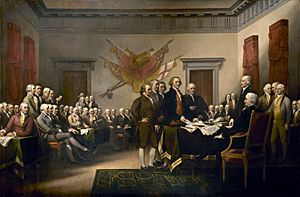
Brown students showed their support for the American Revolution early on. At the first graduation in 1769, President Manning and the graduates wore clothes made in America. This was a protest against British trade rules. In 1775, the graduating class also protested. They were upset about how their country was being treated.
Brown's first Chancellor, Stephen Hopkins, was a delegate to important meetings. He went to the Albany Congress in 1754 and the Continental Congress from 1774 to 1776. He signed the United States Declaration of Independence for Rhode Island. At that time, Stephen Hopkins was both the Chief Justice of Rhode Island and Brown's Chancellor.
In 1776, British ships were in Narragansett Bay. So, the college library was moved out of Providence to keep it safe. During the American Revolutionary War, Brown's University Hall was used by French and other revolutionary troops. These troops were led by General George Washington and the Comte de Rochambeau. They stayed there before their famous march in 1781, which led to the Siege of Yorktown. The building was a barracks and hospital from 1776 to 1780. It was a hospital for French troops from 1780 to 1782.
Many of Brown's founders played important roles in the Revolution. John Brown led the Gaspee Affair. Chief Justice Joshua Babcock was a major general in the state army. William Ellery signed the Declaration of Independence. Another founder, John Gano, was a chaplain during the war. He is said to have baptized George Washington.
James Mitchell Varnum, who graduated in Brown's first class in 1769, became a general under George Washington. He also founded the 1st Rhode Island Regiment, which was the first Black battalion in U.S. military history. David Howell, another early graduate, was a delegate to the Continental Congress.
Late 1700s and 1800s
In 1786, College President James Manning was chosen to represent Rhode Island in the U.S. Congress. He helped suggest changes to the Articles of Confederation. He also helped convince Massachusetts to approve the United States Constitution.
George Washington visited the college in August 1790. He was with George Clinton and Thomas Jefferson. By 1800, more than 100 students were enrolled at the college.
Medical Program and Growth
Brown University started a medical program in 1811. It was the third college in New England to teach medicine. In 1827, Brown's fourth president, Francis Wayland, wanted all teachers to live on campus. The medical doctors refused because it would hurt their private practices. So, President Wayland stopped the medical program. Between 1811 and 1827, 87 students graduated from the medical school.
The early 1800s saw Brown's campus grow. In 1822, the university built its second building, Hope College. Nicholas Brown Jr. paid for it. Then came Manning Hall in 1834 and Rhode Island Hall in 1840. These four buildings formed a line, which shaped Brown's central campus.
Engineering and Diversity
In 1847, Brown started its engineering program. It was the first in the Ivy League to do so. It was also the third-oldest civilian engineering program in the U.S.
Brown welcomed its first African-American students, George W. Milford and Inman E. Page, in 1873.
Women at Brown
Brown began to admit women in 1891. It created a Women's College in Brown University, which was later named Pembroke College in Brown University. In 1971, Pembroke College fully merged with Brown University. This made Brown a co-educational school for all students.
The 1900s
The New Curriculum
In 1850, Brown President Francis Wayland said students should be able to study what they chose. In 1969, Brown adopted the New Curriculum. This was a big step toward Wayland's idea. The curriculum came from a paper written by students Ira Magaziner and Elliot Maxwell. They wanted to "put students at the center of their education." They also wanted to "teach students how to think rather than just teaching facts."
The paper suggested new courses that would combine different subjects. These courses would teach students how to think in different fields. After students rallied for change, a committee was formed. Their ideas, known as the Maeder Report, were voted on by the teachers. On May 7, 1969, the New Curriculum was passed. Its main features included:
- Special courses for first-year students to learn different ways of thinking.
- Courses that combined different subjects.
- Students could choose to take any course as Satisfactory/No Credit.
- Old rules about what courses students had to take were removed.
- Grades were simplified to ABC/No Credit. "No Credit" would not show on official records.
Most of these ideas are still part of Brown's curriculum today.
Brown also works closely with the Rhode Island School of Design (RISD). Brown students can take classes at RISD, and RISD students can take classes at Brown. In 2007, they started a special program. Students can earn two degrees, one from Brown and one from RISD, in five years.
In 2006, there was a discussion about bringing back plus/minus grades. Some people thought it would help with grade inflation. Others said it would not help and would make students compete too much. The idea was voted down.
Re-establishing the Medical School
In 1972, Brown re-opened its medical school. It had been closed since 1827. The first class of 58 students graduated in 1975. In 1991, it was renamed Brown University School of Medicine. In 2000, it became Brown Medical School. In 2007, Warren Alpert donated $100 million. In honor of this gift, the school was renamed The Warren Alpert Medical School of Brown University.
The 2000s
Slavery and Justice
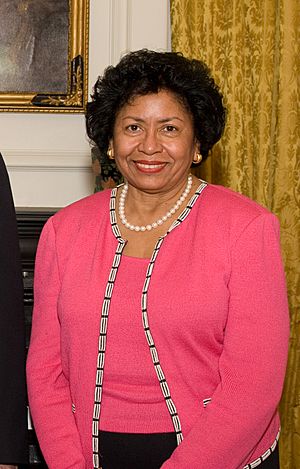
In 2003, Brown University President Ruth Simmons created a committee. It was called the "Steering Committee on Slavery and Justice." This group included teachers, staff, and students. Their job was to study Brown's past connections to slavery and the transatlantic slave trade. The committee researched Brown's history. They also held many public events, like talks and discussions.
Slavery Memorial
In 2014, Brown put up a memorial on campus. It recognizes the university's ties to the slave trade. It also honors the Africans and African-Americans, both enslaved and free, who helped build the school. The memorial, designed by artist Martin Puryear, looks like a large ball and chain partly buried in the ground.
New Schools and Growth
In the early 2000s, Brown added two new divisions. In 2010, Brown's engineering division became a new School of Engineering. In 2011, Brown's Alpert Medical School opened a new campus in Providence. In 2013, Brown's Department of Community Health became an independent School of Public Health.
Brown University Presidents
The current president of Brown University is Christina Hull Paxson. She is the 19th president. She followed Ruth J. Simmons, who was the first African American president of an Ivy League school.
See also
- History of Providence, Rhode Island
- History of Rhode Island
- List of presidents of Brown University
- List of Brown University people


